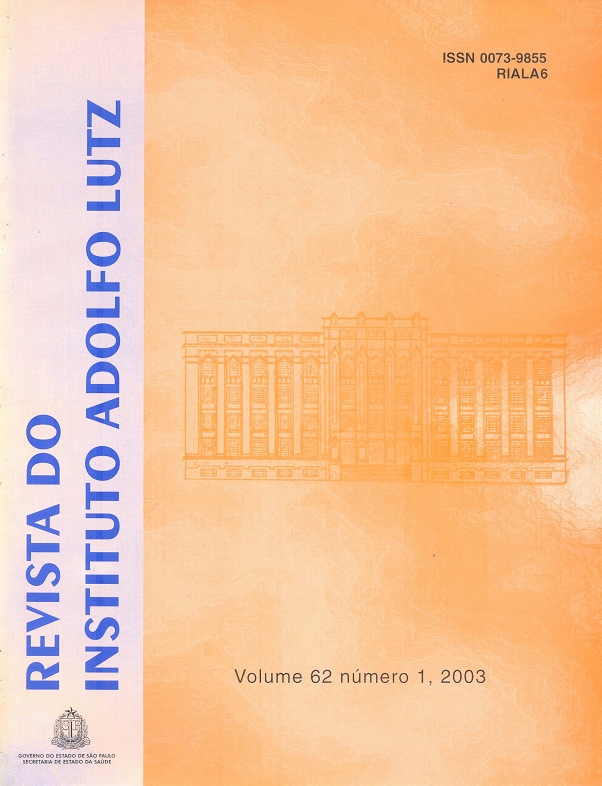Abstract
The aim of this study was to evaluate the hygienic and sanitary quality of soft drinks of different commercial brands, flavours cola, guaraná and fruits. The samples (2 liters Pet) were randomly
collected in commercial establisments by the Inspection Service (VISA/MG). Two methodologies were used to enumerate viable fungi in beverages (APHA, 1992). The first one was the surface spread-plate
technique using Dicloran Rose Bengal Chloranphenicol medium, and the second one was the membrane filter technique, and media: M-Green Yeast and Mold and DRBC medium . 13% of the soft drink samples showed levels of yeast and mold higher than 20 CFU/mL being classified as unacceptable because of its hygienic conditions (Portaria 451/97 of MS/SVS – item XII-a). 46.2% of these samples presented yeasts, 30% yeasts and molds, and 23% molds. Coliforms were not detected in the samples. 92.3% of the
unacceptable samples were provenient from industries classified as bad or precarious according to their premises.
References
1. Brasil. Portaria no 451, de 19 de setembro de 1997 da Vigilância Sanitária – Diário Oficial da União, Brasilia. no 182 – Seção 1, p. 21005-21012, de 22 de setembro de 1997.
2. Brasil. Resolução RDC no 12, de 2 de janeiro de 2001 - Diário Oficial da União, Brasilia. Seção 1 , p. 45 – 53, de 10 de janeiro de 2001. [Agência Nacional de Vigilância Sanitária].
3. Frisvad, J. C. Fungal species and their production of mycotoxins. In: Samson, R. A., editor. Introduction to Food-borne Fungi. Netherlands: Centrallbureau voor Schimmelcultures; 1988. p. 239-49.
4. King, A. D., Hocking, A. D., Pitt, J. I. Dichloran-Rose Bengal Medium for enumeration and isolation of molds from foods. Appl. Environ. Microbiol., 37: 959-64, 1979.
5. Koburger, J. A. & Norden, A. R. Fungi in Foods. J. Milk Food Technol., 38: 745-6, 1975.
6. Mislivec, P. B.; Beuchat, L. R.; Cousin, M. A. Yeasts and Molds. In: Vanderzant, C. & Splittstoesser, D. F., editor. Compedium of Methods for the Microbiological Examination of Foods. 3.ed. Washington: APHA; 1992. p. 239 – 49.
7. Peeler, J. I.; Houghtby, G. A.; Raimoser, A. P. The Most Probable Number Technique. In: Vanderzant, C. & Splittstoesser, D. F. ,editor. Compedium of Methods for the Microbiological Examination of Foods. 3.ed. Washington: APHA; 1992. p. 105 – 20.
8. Pitt, J. I. & Hocking, A. D. Fungi and Food Spoilage. 2.ed. Maryland: Aspen Publishers Inc.; 1999. 593 p.
9. Power, D. A. & McCuen, P. J. Manual of BBL Products and Laboratory Procedures. 6.ed. Becton Dickinson Microbiology Systems, 1988.
10. Samson, R. A., Hocking, A. D., Pitt, J. I., King, A. D. Modern Methods in Food Mycology. Amsterdan: Elsevier; 1992. 388 p.
11. Scussel, V. M. Micotoxinas em Alimentos. Florianópolis: Insular; 1998. 144p.
12. Silva, N., Taniwaki, M. H., Junqueira, V. C. A., Silveira, N. F. A. Manual de Métodos de Análise Microbiológica de Sucos e Refrigerantes. São Paulo: ITAL;1997.154p.
13. Taniwaki, M. H., Iamanaka, B. T., Banhe, A. A. Comparision of culture media to recover fungi from flour and tropical fruit pulp. J. Food Mycol., 2: 291-302, 1999.

This work is licensed under a Creative Commons Attribution 4.0 International License.
Copyright (c) 2003 Revista do Instituto Adolfo Lutz
